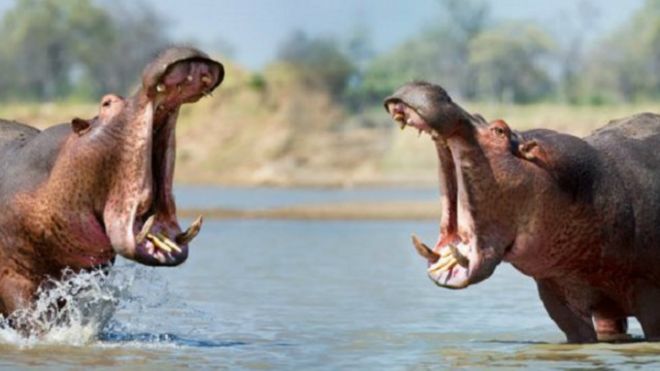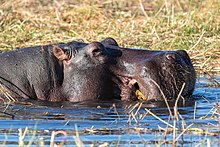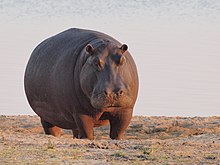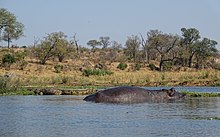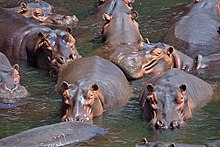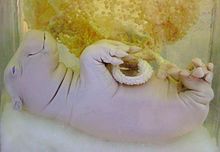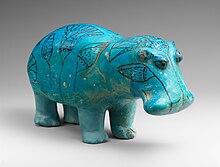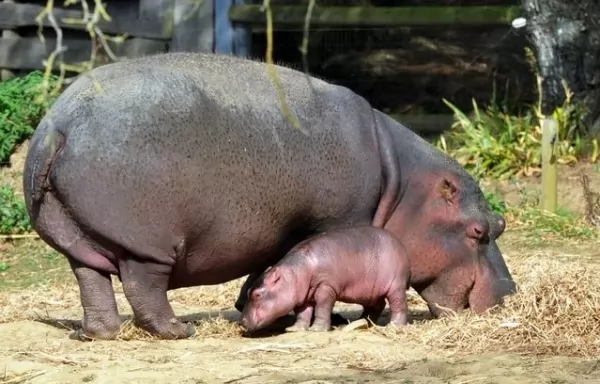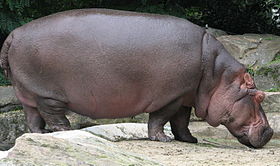
ـــــــــــــــــــــــــــــــــــــــ

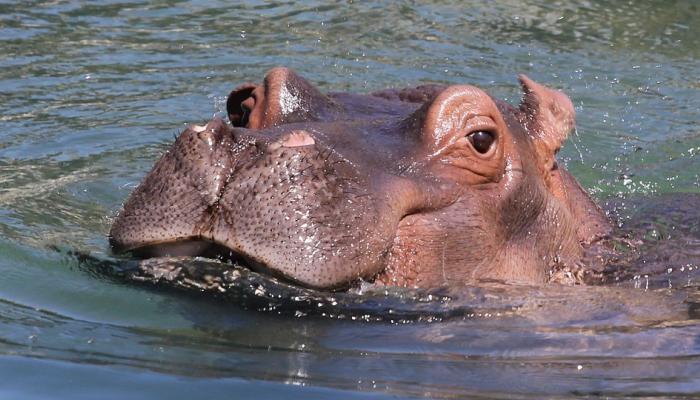
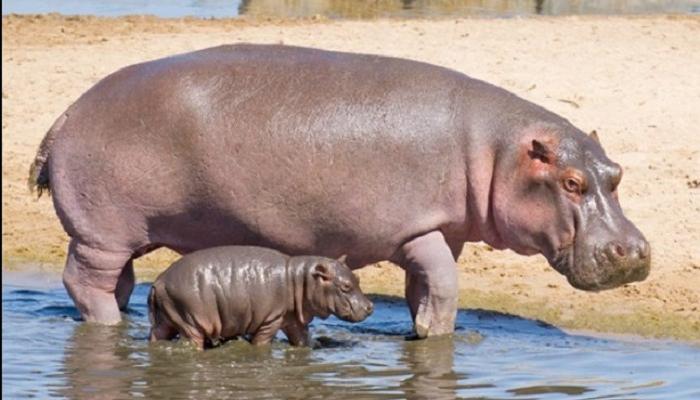
تُصوِّر الأعمال الخيالية أفراس النهر على أنها حيوانات عملاقة تتسم باللطف. ولكنها قد تنقلب في حقيقة الأمر إلى كائنات عنيفة؛ بوسعها حتى قتل البشر.
تتمثل السمعة السائدة عن أفراس النهر في أنها حيوانات لطيفة ولكنها بطيئة وخاملة، من فئة الكائنات آكلة العشب، تقضي حياتها تتقلب وتستلقي وتتحرك باسترخاء في مياه استوائية موحلة، منعزلة عما سواها من حيوانات.
أما الحقيقة فهي أن تلك الحيوانات تتسم بالرشاقة في الحركة، والعدوانية في السلوك على نحو ملحوظ، بل إنها أحيانا ما تقتل – أو تقتات على ما يمكن أن تجده من بقايا – حيوانات مثل الظبي الأفريقي والبقر الوحشي والجاموس.
وفي بعض الأحيان، تقتل أفراس النهر البشر أنفسهم. وخلال جولات ليلية تقوم بها خارج المياه؛ تقطع تلك الحيوانات أميالا عديدة في رحلات مضنية، كي تحصل على وجبات خفيفة وسريعة من النباتات الشهية، بما في ذلك المحاصيل الزراعية، وهو ما يجعل علاقة الجيرة بينها وبين البشر مزعجة ومضطربة.
فإذا ما صدق المرء منّا ما يراه ويقرأه في الأعمال الخيالية؛ فسيعتبر أن أفراس النهر من بين ألطف المخلوقات العملاقة الموجودة في أفريقيا. فهي تُصوّر في هذه الأعمال وهي ترتدي تنورات منتفشة قصيرة للغاية، أو وهي تبذل جهودا مضنية لتعزيز صداقاتها بما حولها.
معلومات عن فرس النهر
فرس النهر
ليست أفراس النهر أكبر ثدييات برية في العالم، ولكنها أكبر سلالات الفيلة ووحيد القرن، ويمكن لأكبر أفراس النهر من الذكور أن تقترب من ثلاثة أطنان و 17 قدمًا، وعلى ما يبدو أنها لا تتوقف عن النمو طوال فترة عمرها الذي يستمر إلى حوالي 50 عامًا، والإناث أقل بضع مئات من الكيلوجرامات، ولكنها تمتلك أيضًا قوة هائلة تدافع بها عن نفسها، ويُنتج فرس النهر من حاجبه مادة تسمى عرق الدم يتكون من أحماض حمراء وبرتقالية تمتص الأشعة فوق البنفسجية وتمنع نمو البكتيريا، وقد أدى ذلك إلى انتشار خرافة مفادها أن عرق أفراس النهر من الدم، وفي الواقع أن هذه الثدييات لا تمتلك أي غدد عرقية على الإطلاق.
صفات فرس النهر
أفراس النهر تشتهر بأحجامها الكبيرة، وهي من بين الحيوانات الإفريقية الضخمة الموجودة على كوكب الأرض الآن، ويمكن توضيح بعض صفات أفراس النهر فيما يأتي:[٢] فرس النهر أصغر في المتوسط من وحيد القرن الأبيض لكنه أكبر من وحيد القرن الأسود والزرافة. يبلغ متوسط وزن الأفراد البالغة من أفراس النهر حوالي 1500 كجم، ويمكن للذكور كبيرة الحجم أن تصل أوزانهم إلى 2000 كجم. يبدو أن أفراس النهر الذكور تستمر في النمو طوال حياتها بينما تصل الإناث إلى الحد الأقصى للوزن عند حوالي 25 عامًا. أفراس النهر برميلية الشكل مع أرجل قصيرة. تتكيف أفراس النهر مع تحمل وزنها الهائل، وجاذبيتها النوعية تسمح لها بالغطس والتحرك على طول قاع الأنهار. يتحرك فرس النهر بواسطة قفزات تشبه قفزات الخنازير. توجد عيون وآذان وخياشيم فرس النهر على سطح منطقة الرأس. تنحدر خصية الذكور جزئيًا فقط، ولا يوجد كيس صفن، وبالإضافة إلى ذلك، يتراجع القضيب إلى الجسم عندما لا يكون منتصبًا. الفك مدعوم من قبل كتلة كبيرة متطورة، وهو يتدحرج إلى خلف اللحاء، ويقع مفصل الفك بعيدًا بما فيه الكفاية للسماح للحيوان بفتح فمه إلى حوالي 180 درجة.
سلوك فرس النهر
يحب فرس النهر المياه، ولهذا السبب أطلق اليونانيون عليه اسم حصان النهر، فهو من الحيوانات التي تقضي وقتًا هائلًا في المياة، ويمكن توضيح سلوك فرس النهر بنقاط موجزة فيما يأتي:[٣] تقضي أفراس النهر ما يصل إلى 16 ساعة في اليوم مغمورًا في الأنهار والبحيرات للحفاظ على أجسادهم الضخمة باردة تحت أشعة الشمس الإفريقية الحارة. أفراس النهر رشيقة في الماء، فهي كائنات تجيد السباحة، ويمكن أن تحبس أنفاسها لمدة تصل إلى خمس دقائق، ومع ذلك، وهي غالبًا ما تكون كبيرة بما يكفي للسير أو الوقوف على قاع البحيرة، أو الاستلقاء في المياه الضحلة. تقوم أفراس النهر أيضًا بالتشمس على الخط الساحلي. يترك فرس النهر الماء عند غروب الشمس ويخرج برًا إلى الأرض في الخارج، وقد يمشي 6 أميال في الليل، لاستهلاك حوالي 80 رطلُا من العشب. تزن صغار فرس النهر ما يقرب من 100 رطلًا عند الولادة ويمكن أن ترضع على الأرض أو تحت الماء عن طريق إغلاق آذانهم وخياشيمهم. تضع كل أنثى من أفراس النهر مولودًا واحدًا فقط كل عامين، وبعد فترة وجيزة تأوي الأم والصغار إلى أماكن أخرى توفر بعض الحماية ضد التماسيح والأسود والضباع.
أنواع فرس النهر
هناك نوعان من فرس النهر، أحدهما هو فرس النهر الشائع، وهو الذي يعيش في الأنهار والبحيرات والمستنقعات في أفريقيا وجنوب الصحراء الكبرى، وأيضًا يتم الاحتفاظ بذلك النوع في حدائق الحيوان، لتجذب الكثير من الزوار، فأغلبها مألوف جدًا في جميع أنحاء العالم، أما النوع الآخر فهو فرس النهر القزم، وهو بحجم خنزير كبير، ويقضي وقتًا أقل في الماء من فرس النهر الشائع، كما أن أعداد ذلك النوع أصغر بكثير، وقد وُجد ذلك النوع من فرس النهر في ليبيريا على عكس فرس النهر الشائع، ويختلف هذا النوع القزم عن النوع الآخر في التغذية؛ حيث يتناول فرس النهر القزم أوراق الشجيرات والأشجار بدلًا من العشب، وهذان النوعان الوحيدان من فرس النهر موجودان اليوم، ولكن في الماضي كان هناك فرس النهر القزم بكثرة، وفي السابق كان هناك عدة أنواع ضخمة من أفراس النهر القزمية، وبعضها كان بحجم بقرة في جزيرة مدغشقر، حيث كانت تعدّ أكبر الحيوانات المحلية.
مخاطر حيوان فرس النهر
رغم الأحجام الكبيرة والهيئات الضخمة التي تبدو عليها أفراس النهر، إلا إنها تتعرض لعدد كبير من التحديات المختلفة التي تتنوع باختلاف الأماكن التي تتواجد بها، فهي أحيانًا تشكل خطرًا على ما حولها، وأحيانًا أخرى تعاني من أخطار كالانقراض، ويمكن توضيح نبذة عن تلك التحديات فيما يأتي:[٥] يعدّ فرس النهر من أكثر الثدييات في العالم التي لها نزعة قاتلة، حيث تقتل تلك الحيوانات العملاقة ما يقدر بنحو 500 شخص سنويًا في أفريقيا. أفراس النهر مجهزة تجهيزًا جيدًا -بحكم بنيتها القوية- لإلحاق ضرر كبير بأي شيء يتجول في أراضيها، فعلى سبيل المثال، في عام 2014، قام فرس نهر بمهاجمة قارب صغير مليء بأطفال المدارس في نيجيريا، مما أسفر عن مقتل اثني عشر طالبًا على متنها. أفراس النهر خطيرة للغاية فيما يتعلق بالدفاع عن صغارها، فهي تستخدم أسنانها وأنيابها الكبيرة لمكافحة التهديدات التي تحيط بصغارها، سواء كانت تلك التهديدات من الحيوانات أو من البشر أيضًا. تحدث النزاعات بين البشر وأفراس النهر عندما يتجول أفراس النهر في البر بحثًا عن الطعام، مما يؤدي لخسائر كبيرة. تدوس أفراس النهر أحيانًا على المحاصيل وتفسد الكثير من المزروعات. وفقًا للاتحاد الدولي لحفظ الطبيعة فإن فرس النهر مثلما يعرض حياة الناس للخطر أحيانًا، فهو كذلك عرضة للانقراض، ويقدر الاتحاد الدولي لحفظ الطبيعة أن ما بين 125000 و148000 من أفراس النهر لا تزال في البرية حتى اليوم، حيث قلل الصيد الجائر من الأرقام العالمية لأعداد فرس النهر خلال أواخر التسعينيات وأوائل الألفية الثانية.

فرس النهر
Hippopotamus
Jump to navigationJump to search
| Hippopotamus | |
|---|---|
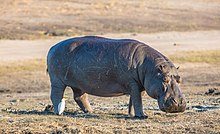 |
|
| A hippopotamus in Chobe National Park, Botswana | |
| Scientific classification |
|
| Kingdom: | Animalia |
| Phylum: | Chordata |
| Class: | Mammalia |
| Order: | Artiodactyla |
| Family: | Hippopotamidae |
| Genus: | Hippopotamus |
| Species: |
H. amphibius
|
| Binomial name | |
| Hippopotamus amphibius | |
 |
|
| Range map of the hippopotamus. Historic range is in red while current range is in green.[1] | |
The hippopotamus (/ˌhɪpəˈpɒtəməs/ HIP-ə-POT-ə-məs;[3] Hippopotamus amphibius), also called the common hippopotamus is a large, mostly herbivorous, semiaquatic mammal and ungulate native to sub-Saharan Africa. It is one of only two extant species in the family Hippopotamidae, the other being the pygmy hippopotamus (Choeropsis liberiensis or Hexaprotodon liberiensis). The name comes from the ancient Greek for “river horse” (ἱπποπόταμος). After the elephant and rhinoceros, both of which are found in Africa, the hippopotamus is the third-largest type of land mammal and the heaviest extant artiodactyl. Despite their physical resemblance to pigs and other terrestrial even-toed ungulates, the closest living relatives of the Hippopotamidae are cetaceans (whales, dolphins, porpoises, etc.) from which they diverged about 55 million years ago.
Hippos are recognisable by their barrel-shaped torsos, wide-opening mouths revealing large canine tusks, nearly hairless bodies, columnar legs and large size; adults average 1,500 kg (3,310 lb) and 1,300 kg (2,870 lb) for males and females respectively. Despite its stocky shape and short legs, it is capable of running 30 km/h (19 mph) over short distances.
Hippos inhabit rivers, lakes, and mangrove swamps, where territorial males preside over a stretch of river and groups of five to thirty females and young hippos. During the day, they remain cool by staying in the water or mud; reproduction and childbirth both occur in water. They emerge at dusk to graze on grasses. While hippos rest near each other in the water, grazing is a solitary activity and hippos are not territorial on land. The hippo is among the most dangerous animals in the world as it is highly aggressive and unpredictable. They are threatened by habitat loss and poaching for their meat and ivory canine teeth.
The Latin word “hippopotamus” is derived from the ancient Greek ἱπποπόταμος, hippopótamos, from ἵππος, híppos, “horse”, and ποταμός, potamós, “river”, meaning “horse of the river”.[4][5][6] In English, the plural is “hippopotamuses”, but “hippopotami” is also used;[7] “hippos” can be used as a short plural. Hippos are gregarious, living in groups of up to thirty animals. A group is called a pod, herd, dale, or bloat.
Taxonomy and origins
Classification
Hippopotamus is the type genus of the family Hippopotamidae. The pygmy hippopotamus belongs to a different genus in Hippopotamidae, either Choeropsis or Hexaprotodon. Hippopotamidae are sometimes known as hippopotamids. Sometimes, the subfamily Hippopotaminae is used. Further, some taxonomists group hippos and anthracotheres in the superfamily Anthracotheroidea.[8]:39 Hippopotamidae are classified along with other even-toed ungulates in the order Artiodactyla. Other artiodactyls include camels, cattle, deer and pigs, although hippos are not closely related to these groups.
Five subspecies of hippos have been described based on morphological differences in their skulls and geographical differences:[8]:3
- Great northern hippopotamus or Nile hippopotamus H. a. amphibius – (the nominate subspecies) which stretched from Egypt, where they are now extinct, south up the Nile River to Tanzania and Mozambique
- East African hippopotamus H. a. kiboko – in Kenya in the African Great Lakes region, and in Somalia in the Horn of Africa. Broader nasals and more hollowed interorbital region
- Cape hippopotamus or South African hippopotamus H. a. capensis – from Zambia to South Africa, most flattened skull of the subspecies
- West African hippopotamus or Tchad hippopotamus H. a. tschadensis – throughout Western Africa to, as the name suggests, Chad, slightly shorter and wider face, with prominent orbits
- Angola hippopotamus H. a. constrictus – in Angola, the southern Democratic Republic of Congo and Namibia, named for its deeper preorbital constriction
The suggested subspecies were never widely used or validated by field biologists; the described morphological differences were small enough that they could have resulted from simple variation in nonrepresentative samples.[8]:2 Genetic analyses have tested the existence of three of these putative subspecies. A study examining mitochondrial DNA from skin biopsies taken from 13 sampling locations, considered genetic diversity and structure among hippo populations across the continent. The authors found low, but significant, genetic differentiation among H. a. amphibius, H. a. capensis, and H. a. kiboko. Neither H. a. tschadensis nor H. a. constrictus has been tested.[9][10]
Evolution

Evolutionary relationships among hippo and Cetacea (whales, dolphins).[11]
Until 1909, naturalists grouped hippos with pigs, based on molar patterns. Several lines of evidence, first from blood proteins, then from molecular systematics[12] and DNA [13][14] and the fossil record, show that their closest living relatives are cetaceans – whales, dolphins and porpoises.[15] The common ancestor of hippos and whales branched off from Ruminantia and the rest of the even-toed ungulates; the cetacean and hippo lineages split soon afterwards.[13][16]
| Artiodactyla |
|
||||||||||||||||||||||||

Anthracotherium magnum from the Oligocene of Europe
The most recent theory of the origins of Hippopotamidae suggests that hippos and whales shared a common semiaquatic ancestor that branched off from other artiodactyls around 60 million years ago.[13][15] This hypothesised ancestral group likely split into two branches around 54 million years ago.[12]
One branch would evolve into cetaceans, possibly beginning about 52 million years ago, with the protowhale Pakicetus and other early whale ancestors collectively known as Archaeoceti, which eventually underwent aquatic adaptation into the completely aquatic cetaceans.[16] The other branch became the anthracotheres, a large family of four-legged beasts, the earliest of which in the late Eocene would have resembled skinny hippos with comparatively small and narrow heads. All branches of the anthracotheres, except that which evolved into Hippopotamidae, became extinct during the Pliocene without leaving any descendants.[15]
A rough evolutionary lineage can be traced from Eocene and Oligocene species: Anthracotherium and Elomeryx to the Miocene species Merycopotamus and Libycosaurus and the very latest anthracotheres in the Pliocene.[17] Merycopotamus, Libycosaurus and Hippopotamidae can be considered to form a clade, with Libycosaurus being more closely related to hippos. Their common ancestor would have lived in the Miocene, about 20 million years ago. Hippopotamidae are therefore deeply nested within the family Anthracotheriidae.
Hippopotamidae are believed to have evolved in Africa; the oldest known hippopotamid is the genus Kenyapotamus, which lived in Africa from 16 to 8 million years ago. While hippopotamid species spread across Asia and Europe, no hippos have ever been discovered in the Americas, although various anthracothere genera emigrated into North America during the early Oligocene. From 7.5 to 1.8 million years ago, an ancestor to the modern hippo, Archaeopotamus, lived in Africa and the Middle East.[18]
While the fossil record of hippos is still poorly understood, the two modern genera, Hippopotamus and Choeropsis (sometimes Hexaprotodon), may have diverged as far back as 8 million years ago. Taxonomists disagree whether or not the modern pygmy hippopotamus is a member of Hexaprotodon – an apparently paraphyletic genus, also embracing many extinct Asian hippopotamuses, that is more closely related to Hippopotamus – or of Choeropsis, an older and basal genus.[17][18]
Extinct species
Three species of Malagasy hippopotamus became extinct during the Holocene on Madagascar, one of them within the past 1,000 years. The Malagasy hippos were smaller than the modern hippo, likely through the process of insular dwarfism.[19] Fossil evidence indicates many Malagasy hippos were hunted by humans, a likely factor in their eventual extinction.[19] Isolated members of Malagasy hippos may have survived in remote pockets; in 1976, villagers described a living animal called the kilopilopitsofy, which may have been a Malagasy hippo.[20]
Three species of hippopotamus, the European hippopotamus (Hippopotamus antiquus), Hippopotamus major and Hippopotamus gorgops, ranged throughout continental Europe and the British Isles. All three species became extinct before the last glaciation. Ancestors of European hippos found their way to many islands of the Mediterranean Sea during the Pleistocene.[21] The Pleistocene also saw a number of dwarf species evolve on several Mediterranean islands, including Crete (Hippopotamus creutzburgi), Cyprus (the Cyprus dwarf hippopotamus, Hippopotamus minor), Malta (Hippopotamus melitensis), and Sicily (Hippopotamus pentlandi). Of these, the Cyprus dwarf hippo survived until the end of the Pleistocene or early Holocene. Evidence from an archaeological site, Aetokremnos, continues to cause debate on whether or not the species was encountered, and was driven to extinction, by man.[22][21]
Physical attributes
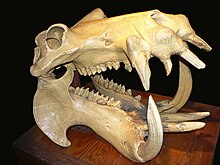
Hippo’s skull, showing the large canines and incisors used for fighting
Hippos are among the largest living land mammals, being only smaller than elephants and some rhinoceroses. Among the extant African megafauna, behind the two African elephant species, they average smaller than the white rhinoceros but are larger by body mass than the black rhinoceros and the giraffe. Mean adult weight is around 1,500 kg (3,310 lb) and 1,300 kg (2,870 lb) for males and females respectively,[23][24] very large males can reach 2,000 kg (4,410 lb) and exceptional males weighing 2,660 kg (5,860 lb)[23], 3,200 kg (7,050 lb)[25] and 4,500 kg (9,920 lb) (in captivity)[26] have been reported. Male hippos appear to continue growing throughout their lives while females reach maximum weight at around age 25.[27]
Hippos have barrel-shaped bodies with short legs and long muzzles.[28] Their skeletal structures are graviportal,[8]:8 adapted to carrying their enormous weight, and their specific gravity allows them to sink and move along the bottom of a river.[29] Hippopotamuses have small legs (relative to other megafauna) because the water in which they live reduces the weight burden.[30] Though they are bulky animals, hippos can gallop at 30 km/h (19 mph) on land but normally trot. They are incapable of jumping but do climb up steep banks.[28] Despite being semiaquatic and having webbed feet, an adult hippo is not a particularly good swimmer nor can it float. It is rarely found in deep water; when it is, the animal moves by porpoise-like leaps from the bottom.[8]:3 The eyes, ears, and nostrils of hippos are placed high on the roof of their skulls. This allows these organs to remain above the surface while the rest of the body submerges.[31]:259 The testes of the males descend only partially and a scrotum is not present. In addition, the penis retracts into the body when not erect. The genitals of the female hippos are unusual in that the vagina is ridged and two large diverticula protrude from the vulval vestibule. The function of these is unknown.[8]:28–29
The hippo’s jaw is powered by a large masseter and a well-developed digastric; the latter loops up behind the former to the hyoid.[31]:259 The jaw hinge is located far back enough to allow the animal to open its mouth at almost 180°.[8]:17 A moderate folding of the orbicularis oris muscle allows the hippo to achieve such a gape without tearing any tissue.[32] The bite force of an adult female hippo has been measured as 8,100 newtons (1,800 lbf).[33] Hippo teeth sharpen themselves as they grind together. The lower canines and lower incisors are enlarged, especially in males, and grow continuously. The incisors can reach 40 cm (1 ft 4 in), while the canines reach up to 50 cm (1 ft 8 in).[28] The canines and incisors are used for combat and play no role in feeding. Hippos rely on their broad horny lips to grasp and pull grasses which are then ground by the molars.[31]:259, 263 The hippo is considered to be a pseudoruminant; it has a complex three-chambered stomach but does not “chew cud“.[8]:22

Completely submerged hippo (San Diego Zoo)
Unlike most other semiaquatic animals, hippos have very little hair.[31]:260 The skin is 6 cm (2 in) thick,[28] providing it great protection against conspecifics and predators. By contrast, its subcutaneous fat layer is thin.[8]:3 The animals’ upper parts are purplish-grey to blue-black, while the under parts and areas around the eyes and ears can be brownish-pink.[31]:260 Their skin secretes a natural sunscreen substance which is red-coloured. The secretion is sometimes referred to as “blood sweat”, but is neither blood nor sweat. This secretion is initially colourless and turns red-orange within minutes, eventually becoming brown. Two distinct pigments have been identified in the secretions, one red (hipposudoric acid) and one orange (norhipposudoric acid). The two pigments are highly acidic compounds. They inhibit the growth of disease-causing bacteria, and their light absorption peaks in the ultraviolet range, creating a sunscreen effect.[34][35] All hippos, even those with different diets, secrete the pigments, so it does not appear that food is the source of the pigments. Instead, the animals may synthesise the pigments from precursors such as the amino acid tyrosine.[35] Nevertheless, this natural sunscreen cannot prevent the animal’s skin from cracking if it stays out of water too long.[36] The secretion does help regulate the body temperature of the hippo and acts an antibiotic source.[37]
A hippo’s lifespan is typically 40–50 years.[31]:277 Donna the Hippo was the oldest living hippo in captivity. She lived at the Mesker Park Zoo in Evansville, Indiana in the US[38][39] until her death in 2012 at the age of 61.[40]
Distribution and status
Hippopotamus amphibius was widespread in North Africa and Europe during the Eemian[41] and late Pleistocene until about 30,000 years ago. Archaeological evidence exists of its presence in the Levant, dating to less than 3,000 years ago.[42][43] The species was common in Egypt‘s Nile region during antiquity, but has since been extirpated. Pliny the Elder writes that, in his time, the best location in Egypt for capturing this animal was in the Saite nome;[44] the animal could still be found along the Damietta branch after the Arab Conquest in 639. Reports of the slaughter of the last hippo in Natal Province were made at the end of the 19th century.[45] Hippos are still found in the rivers and lakes of the northern Democratic Republic of the Congo, Uganda, Tanzania and Kenya, north through to Ethiopia, Somalia and Sudan, west to The Gambia, and south to South Africa.
Genetic evidence suggests that common hippos in Africa experienced a marked population expansion during or after the Pleistocene, attributed to an increase in water bodies at the end of the era. These findings have important conservation implications as hippo populations across the continent are currently threatened by loss of access to fresh water.[9] Hippos are also subject to unregulated hunting and poaching. In May 2006, the hippo was identified as a vulnerable species on the IUCN Red List drawn up by the International Union for Conservation of Nature (IUCN), with an estimated population of between 125,000 and 150,000 hippos, a decline of between 7% and 20% since the IUCN’s 1996 study. Zambia (40,000) and Tanzania (20,000–30,000) possess the largest populations.[1]
The hippo population declined most dramatically in the Democratic Republic of the Congo.[46] By 2005, the population in Virunga National Park had dropped to 800 or 900 from around 29,000 in the mid-1970s.[47] The decline is attributed to the disruptions caused by the Second Congo War.[47] The poachers are believed to be Mai-Mai rebels, poorly paid Congolese soldiers, and local militia groups.[47][48] Reasons for poaching include the belief that hippos are harmful to society, as well as financial gain.[49] However, as of 2016, the Virunga hippo population appears to have increased, possibly due to greater enforcement and cooperation between fishermen and park authorities.[50] The sale of hippo meat is illegal, but black-market sales are difficult for Virunga National Park officers to track.[48][49] Hippo meat is considered a delicacy in some areas of central Africa and the teeth have become a valued substitute for elephant ivory.[51]
As an introduced species
In the late 1980s, Colombian drug lord Pablo Escobar kept four hippos in a private menagerie at his residence in Hacienda Nápoles, 100 kilometres (62 mi) east of Medellín, Colombia. They were deemed too difficult to seize and move after Escobar’s death, and hence left on the untended estate. By 2007, the animals had multiplied to 16 and had taken to roaming the area for food in the nearby Magdalena River.[52][53] In 2013, the National Geographic Channel produced a documentary about them titled Cocaine Hippos.[54] As of early 2014, 40 hippos were reported to exist in Puerto Triunfo, Antioquia from the original four belonging to Escobar,[55] and in 2018 the growing population was estimated at 50–70.[56] In December 2019, it was estimated that there were 65–80 individuals with their range covering almost 2,000 km2 (770 sq mi) in Antioquia, Bolívar, Boyacá, Cundinamarca and Santander; it is expected that the population will increase to 150 individuals within a decade and that the range eventually could cover more than 13,500 km2 (5,200 sq mi).[57] Population projections estimate that there could be thousands within a few decades.[58]
Being non-native introductions, most conservationists considered them problematic and invasive in Colombia, as they have the potential to change the ecosystems, feeding heavily on plants and displacing native species like the West Indian manatee, Neotropical otter, spectacled caiman and turtles.[57][59][60] The critically endangered Dahl’s toad-headed turtle and Magdalena River turtle are largely restricted to the Magdalena River basin,[61] as are many threatened fish.[62] In 2020, a study showed that there was an increase in the nutrient levels and cyanobacteria in Colombian lakes inhabited by hippos. Cyanobacteria can cause toxic algae blooms and die-offs of aquatic fauna. Despite the limited magnitude of the observed change, it was noticeable since the species’ population was still quite small.[59][60] Additionally, they can represent a serious threat to fishers and other locals. There have been attacks on humans, but as of 2017 nobody had been killed or seriously injured by the Colombian hippos.[63]
In contrast to the opposition by most conservationists, some ecologists have argued that they should remain and might even have a positive effect on the local environment. It has been suggested that the nutrients they introduce to the water and the occasional fish kills caused by them are overall positive,[59] but this was based on a study in their native Africa.[64] Alternatively, the introduced hippos could be a form of Pleistocene rewilding project, replacing species like Toxodon that became extinct in prehistoric times,[59] but Pleistocene rewilding itself is highly controversial.[65] Others have argued that the Colombian hippos should be regarded as a safe population, isolated from the threats faced by African hippos, and that they could be benefitial to the local ecotourism industry.[59]
In 2009, two adults and one calf left their herd and, after attacking humans and killing cattle, one of the adults (called “Pepe”) was killed by hunters under authorisation of the local authorities.[53] When a photo of the dead hippo became public, it caused considerable controversy among animal rights groups both within the country and abroad, and further plans of culling ceased. Alternative methods have been considered, but they are unproven, or difficult and expensive. A wild male hippo was caught, castrated and released again, but it cost about US$50,000.[63] As of 2020, there were no plans by the local government on managing the population, but further studies on their effect on the habitat have been initiated.[59] Because of the fast-growing population, conservationists have recommended that a management plan needs to be rapidly developed.[57][58]
Behaviour and life history
Hippos differ from all other large land mammals, being of semiaquatic habits, and spending their days in lakes and rivers.[8]:3 They can be found in both savannah and forest areas.[1] Proper habitat requires enough water to submerge in and grass nearby.[28] Larger densities of the animals inhabit quiet waters with mostly firm, smooth sloping beaches. Male hippos may be found in very small numbers in rapid waters in rocky gorges.[31]:264 Hippos mostly live in freshwater habitats, however populations in West Africa mostly inhabit estuarine waters and may even be found at sea.[1] With the exception of eating, most of a hippo’s life occurs in the water. Hippos leave the water at dusk and travel inland, sometimes up to 15 km (9 mi),[28] to graze on short grasses, their main source of food. They spend four to five hours grazing and can consume 68 kg (150 lb) of grass each night.[66]
Like most herbivores, hippos consume other plants if presented with them, but their diet in nature consists almost entirely of grass, with only minimal consumption of aquatic plants.[67] Hippos are born with sterile intestines, and require bacteria obtained from their mothers’ feces to digest vegetation.[68] On occasion, hippos have been filmed eating carrion, usually near the water. There are other reports of meat-eating, and even cannibalism and predation.[69] The stomach anatomy of a hippo is not suited to carnivory, and meat-eating is likely caused by aberrant behaviour or nutritional stress.[8]:84

Video of hippos in the wild
Hippo defecation creates allochthonous deposits of organic matter along the river beds. These deposits have an unclear ecological function.[67] A 2015 study concluded that hippo dung provides nutrients from terrestrial material for fish and aquatic invertebrates,[70] while a 2018 study found that their dung can be toxic to aquatic life in large quantities, due to absorption of dissolved oxygen in water bodies.[71][72] Because of their size and their habit of taking the same paths to feed, hippos can have a significant impact on the land across which they walk, both by keeping the land clear of vegetation and depressing the ground. Over prolonged periods, hippos can divert the paths of swamps and channels.[73]
Adult hippos move at speeds up to 8 km/h (5 mph) in water; typically resurfacing to breathe every three to five minutes. The young have to breathe every two to three minutes.[8]:4 The process of surfacing and breathing is subconscious: a hippo sleeping underwater will rise and breathe without waking up. A hippo closes its nostrils when it submerges into the water.[74] As with fish and turtles on a coral reef, hippos occasionally visit cleaning stations and signal, by opening their mouths wide, their readiness for being cleaned of parasites by certain species of fishes. This is an example of mutualism, in which the hippo benefits from the cleaning while the fish receive food.[75] The hippos spend up to 16 hours a day in water as a way to stay cool.[37]
Hippos coexist with a variety of large predators. Nile crocodiles, lions and spotted hyenas are known to prey on young hippos.[31]:273[8]:118 However, due to their aggression and size, adult hippos are not usually preyed upon by other animals. Cases where large lion prides have successfully preyed on adult hippos have been reported; however, this predation is generally rare.[76] Lions occasionally prey on adults at Gorongosa National Park and calves are sometimes taken at Virunga.[77] Crocodiles are frequent targets of hippo aggression, probably because they often inhabit the same riparian habitats; crocodiles may be either aggressively displaced or killed by hippos.[78] In turn, beyond cases of killing the seldom unguarded hippo calf, very large Nile crocodiles have been verified to occasionally prey on “half-grown” hippos and anecdotally perhaps adult female hippos. Aggregations of crocodiles have also been seen to dispatch still-living male hippos that have been previously injured in mating battles with other males.[79][80][81]
Social spacing
Studying the interaction of males and females has long been complicated because hippos are not sexually dimorphic; thus females and young males are almost indistinguishable in the field.[82] Although hippos lie close to each other, they do not seem to form social bonds except between mothers and daughters, and they are not social animals. The reason they huddle close together is unknown.[8]:49 Hippos are territorial only in water, where a male presides over a small stretch of river, on average 250 m (270 yd) in length, and containing 10 females. The largest pods can contain over 100 hippos.[8]:50 Younger bachelors are allowed in a male’s stretch, as long as they behave submissively toward the male. The territories of hippos exist to establish mating rights. Within the pods, the hippos tend to segregate by gender. Bachelors lounge near other bachelors, females with other females, and the male on his own. When hippos emerge from the water to graze, they do so individually.[8]:4
Hippos mark their territory by defecation. While depositing the faeces, hippos spin their tails to distribute their excrement over a greater area.[83] “Yawning” serves as a threat display.[28] When fighting, males use their incisors to block each other’s attacks and their large canines to inflict injuries.[31]:260 When hippos become over-populated or a habitat is reduced, males sometimes attempt infanticide, but this behaviour is not common under normal conditions.[84] Incidents of hippo cannibalism have been documented, but this is believed to be the behaviour of distressed or sick hippos.[8]:82–83
Hippos appear to communicate vocally, through grunts and bellows, and they may practice echolocation, but the purpose of these vocalisations is currently unknown. Hippos have the unique ability to hold their heads partially above the water and send out a cry that travels through both water and air; individuals respond above and under water.[85] Hippos will also express threat and alarm with exhalations.[28]
Reproduction
Female hippos reach sexual maturity at five to six years and have a gestation period of eight months.[86] A study of endocrine systems revealed that female hippos may begin puberty as early as three or four years.[87] Males reach maturity at around 7.5 years. A study of hippo reproductive behaviour in Uganda showed that peak conceptions occurred during the end of the wet season in the summer, and peak births occurred toward the beginning of the wet season in late winter. This is because of the female’s oestrous cycle; as with most large mammals, male hippo spermatozoa is active year-round. Studies of hippos in Zambia and South Africa also showed evidence of births occurring at the start of the wet season.[8]:60–61 After becoming pregnant, a female hippo will typically not begin ovulation again for 17 months.[87]
Mating occurs in the water, with the female submerged for most of the encounter,[8]:63 her head emerging periodically to draw breath. Female hippos isolate themselves to give birth and return within 10–14 days.[28] Calves are born underwater at a weight between 25 and 50 kg (55 and 110 lb) and an average length of around 127 cm (4.17 ft), and must swim to the surface to take their first breaths. A mother typically gives birth to only one calf, although twins also occur. The young often rest on their mothers’ backs when the water is too deep for them, and they swim under water to suckle. They suckle on land when the mother leaves the water.[8]:64
Mother hippos are very protective of their young and may keep others at a distance. However, calves are occasionally left in nurseries which are guarded by one or a few adults. Calves in nurseries engage in playfights.[28] Weaning starts between six and eight months after birth, and most calves are fully weaned after a year.[8]:64 Like many other large mammals, hippos are described as K-strategists, in this case typically producing just one large, well-developed infant every couple of years (rather than many small, poorly developed young several times per year as is common among small mammals such as rodents).[87][84]
Hippos and humans
The earliest evidence of human interaction with hippos comes from butchery cut marks on hippo bones at Bouri Formation dated around 160,000 years ago.[88] Later rock paintings and engravings showing hippos being hunted have been found in the mountains of the central Sahara dated 4,000–5,000 years ago near Djanet in the Tassili n’Ajjer Mountains.[8]:1 The ancient Egyptians recognised the hippo as a ferocious denizen of the Nile and representations on the tombs of nobles show that the animals were hunted.[89]
The hippo was also known to the Greeks and Romans. The Greek historian Herodotus described the hippo in The Histories (written circa 440 BC) and the Roman naturalist Pliny the Elder wrote about the hippo in his encyclopedia Naturalis Historia (written circa 77 AD).[44][90] The Yoruba people called the hippo erinmi, which means “elephant of the water”.[91] Zulu warriors preferred to be as brave as a hippo, since even lions were not considered to match its courage.[92] They would chant their chief: “Een-gonyama Gonyama! Invooboo! Yah-bo! Yah-bo! Invooboo!” which translates as “He is a lion. Yes, he is better than a lion – he is a hippopotamus.”[93]
Attacks on humans
The hippo is considered to be extremely aggressive and has frequently been reported charging and attacking boats.[94] Small boats can easily be capsized by hippos and passengers can be injured or killed by the animals or drown. In one 2014 case in Niger, a boat was capsized by a hippo and 13 people were killed.[95] As hippos will often engage in raiding nearby crops if the opportunity arises, humans may also come in conflict with them on these occasions, with potential for fatalities on both sides.[96]
In zoos
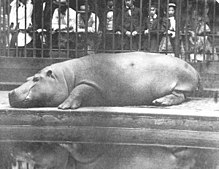
Obaysch lounging at the London Zoo in 1852
Hippos have long been popular zoo animals. The first zoo hippo in modern history was Obaysch, who arrived at the London Zoo on 25 May 1850, where he attracted up to 10,000 visitors a day and inspired a popular song, the “Hippopotamus Polka”.[97] Hippos generally breed well in captivity; birth rates are lower than in the wild, but this is attributed to zoos wanting to limit births, since hippos are relatively expensive to maintain.[8]:129[97][98]
Like many zoo animals, hippos were traditionally displayed in concrete exhibits. In the case of hippos, they usually had a pool of water and patch of grass. In the 1980s, zoo exhibits increasingly reflected native habitats. For example, the Toledo Zoo Hippoquarium features a 360,000-US-gallon (1,400,000 l) pool.[99] In 1987, the Toledo Zoo saw the first underwater birth by a captive hippo.[100] The exhibit was so popular, the hippos became the logo of the Toledo Zoo.[101]
Cultural depictions
A red hippo represented the Ancient Egyptian god Set; the thigh is the “phallic leg of Set”, symbolising virility. Set’s consort Tawaret was also seen as part hippo[102] and was a goddess of protection in pregnancy and childbirth, because ancient Egyptians recognised the protective nature of a female hippo toward her young.[103] The Ijaw people of the Niger Delta wore masks of aquatic animals like the hippo when practicing their water spirit cults[104] and hippo ivory was used in the divination rituals of the Yoruba.[105] The Behemoth from the Book of Job, 40:15–24 is thought to be based on a hippo.[106]
Hippos have been the subjects of various African folktales. According to a San story; when the Creator assigned each animal its place in nature, the hippos wanted to live in the water, but were refused out of fear that they might eat all the fish. After begging and pleading, the hippos were finally allowed to live in the water on the conditions that they would eat grass instead of fish and would fling their dung so that it can be inspected for fish bones. In a Ndebele tale, the hippo originally had long, beautiful hair, but was set on fire by a jealous hare and had to jump into a nearby pool. The hippo lost most of his hair and was too embarrassed to leave the water.[107]
Ever since Obaysch inspired the “Hippopotamus Polka”, hippos have been popular animals in Western culture for their rotund appearance that many consider comical.[97] Stories of hippos such as Huberta, which became a celebrity in South Africa in the 1930s for trekking across the country;[108] or the tale of Owen and Mzee, a hippo and tortoise which developed an intimate bond; have amused people who have bought hippo books, merchandise, and many stuffed hippo toys.[109][110] Hippos were mentioned in the novelty Christmas song “I Want a Hippopotamus for Christmas” that became a hit for child star Gayla Peevey in 1953. They also feature in the songs “The Hippopotamus” and “Hippo Encore” by Flanders and Swann, with the famous refrain “Mud, Mud, Glorious Mud”. They even inspired a popular board game, Hungry Hungry Hippos.[111][112]
Hippos have also been popular cartoon characters, where their rotund frames are used for humorous effect. For example, the Disney film Fantasia featured a ballerina hippo dancing to the opera La Gioconda,[46] and Hanna-Barbera created Peter Potamus.[113]
The “Happy Hippos” characters were created in 1987 by the French designer André Roche to be hidden in the “Kinder Surprise egg” of the Italian chocolate company Ferrero SpA.[114]
|
فرس النهر |
|
|---|---|
|
|
|
| حالة الحفظ | |
 أنواع مهددة بالانقراض (خطر انقراض أدنى)[1] |
|
| المرتبة التصنيفية | نوع[2][3] |
| التصنيف العلمي | |
| النطاق: | حقيقيات النوى |
| المملكة: | الحيوانات |
| الشعبة: | الحبليات |
| الطائفة: | الثدييات |
| الرتبة: | مزدوجات الأصابع |
| الفصيلة: | البرنيقيات |
| الجنس: | فرس النهر |
| النوع: | فرس النهر |
| الاسم العلمي | |
| Hippopotamus amphibius [2][3] لينيوس، 1758 |
|
| فترة الحمل | 8 شهر |
|
موطن فرس النهر في إفريقيا
|
|
|
|
|
فرس النهر، والذي يُسمى أيضا فرس النهر المألوف (الاسم العلمي: Hippopotamus amphibius) هو حيوان أفريقي ضخم عاشب. إجمالا يعد أحد النوعين المتبقيين على قيد الحياة اليوم من فصيلة البرنيقيات (الآخر هو فرس النهر القزم). يعرف فرس النهر باللغة العربية أيضا بالبرنيق وسيد قشطة كما يسمونه في مصر نسبة للاسم الذي أطلق على أول حيوان أودع بحديقة الحيوانات بالجيزة عند أنشائها، ويشتق اسماه اللاتيني “هيبوبوتاموس” (باللاتينية: Hippopotamus) من الكلمة اليونانية “ἱπποπόταμος” حيث أن “هيبوس” (باليونانية : ιππος) تعني حصان و”بوتاموس” (باليونانية: πόταμος) تعني نهر.[4]
فرس النهر حيوان شبه مائي وهو يستوطن البحيرات والأنهار في أفريقيا جنوب الصحراء الكبرى وقد امتد موطنه في السابق عبر وادي النيل وصولاً إلى فلسطين والأردن شمالاً. تعيش أفراس النهر في مجموعات يبلغ عدد أفرادها حوالي 40 رأسا، وهي تبقى معظم النهار في الماء أو الوحل حتى تتبرّد. يحصل التزاوج والولادة في الماء حيث تقوم الذكور الإقليمية بالتقاتل مع بعضها للسيطرة على مجال صغير من النهر، وتخرج أفراس النهر عند الغسق لترعى الأعشاب ويعتبر الرعي نشاطا فرديا يقوم به كل فرد وحده أي أن الأفراس لا تتجمع كما تفعل عندما تكون في الماء قرب بعضها البعض.
تعتبر الحيتانيات مثل الحيتان وخنازير البحر وأقربائها هي أقرب الحيوانات لأفراس النهر على الرغم من تشابه تلك الأخيرة مع الخنازير وغيرها من الحافريات المزدوجة الأصابع. يقدر العلماء أن أفراس النهر انفصلت عن أقربائها مند حوالي 55 مليون سنة،[5] وأن السلف المشترك للحيتان وأفراس النهر انفصل عن باقي مزدوجات الأصابع منذ حوالي 60 مليون سنة،[6] أما أقدم المستحثات لفرس النهر فيقدر عمرها بحوالي 16 مليون سنة وقد وجدت في أفريقيا وهي تنتمي إلى جنس “فرس النهر الكيني” (باللاتينية: Kenyapotamus).
يعرف فرس النهر بواسطة جسده الأسطواني الشكل والعديم الشعر، القوائم القصيرة، والحجم الضخم. يقارب فرس النهر وحيد القرن الأبيض في حجمه ولا يفوقه في القد سوى الفيلة، وعلى الرغم من قصر قوائمه فإن هذا الحيوان قادر على أن يسبق إنساناً بسهولة في الجري فقد تم قياس سرعته بحدود 30 ميلا في الساعة وبالتالي فيمكن اعتبار أنه قادر على أن يسبق عدّاءً أولمبياً في سباق للمسافات القصيرة. يعتبر فرس النهر من أشد الحيوانات خطورة على الإنسان على الرغم من شيوعه في حدائق الحيوانات وإظهاره بمظهر “العملاق اللطيف”. يعيش حاليا ما بين 125,000 إلى 150,000 فرس نهر في البريّة جنوبي الصحراء الكبرى، وتعتبر زامبيا (40,000 رأس) وتنزانيا (20,000 – 30,000 رأس) الدول التي تؤوي أكبر أعداد من هذه الحيوانات،[7] ولا تزال أفراس النهر مهددة حالياً من القنص الغير شرعي للحصول على لحمها وأنيابها العاجيّة ومن فقدان المسكن.
أصل النوع وتصنيفه
فرس النهر حيوان اجتماعي يعيش في قطعان يبلغ عدد أفرادها 40 حيوانا، ويسمّى فرس النهر الذكر “ثوراً” بحسب التعبير الإنكليزي وتسمى الأنثى “بقرة” ويسمى الصغير “عجلاً”.[8] يُعرف هذا النوع أيضا باسم فرس النهر المألوف وفرس النهر النيلي وذلك لتميزها عن فرس النهر القزم وغيره من الأنواع المنقرضة، إلا أن مجرد التعبير بقول “فرس النهر” يقصد به إجمالا هذا النوع.
يعتبر جنس أفراس النهر هو الممثل الرئيسي لفصيلة البرنيقيات على الرغم من أن فرس النهر القزم يمثل جنساً آخر بحد ذاته. وقد تم تصنيف خمس سلالات من فرس النهر بناء على اختلافات تشكّليّة في جماجمها والمنطقة الجغرافية التي تقطنها:[9]
- السلالة البرمائية (Hippopotamus amphibius amphibius ) – التي امتد موطنها في السابق من فلسطين والأردن حتى مصر (حيث انقرضت الآن) نزولا عبر وادي النيل حتى تنزانيا وموزامبيق.
- السلالة السواحيليّة ، سلالة كيبوكو (Hippopotamus amphibius kiboko) – في القرن الإفريقي، كينيا والصومال. كيبوكو هو الاسم السواحيلي لفرس النهر، وتتميز هذه السلالة عن غيرها بفتحات أنفية أوسع وتجويف أكبر في الجمجمة.
- سلالة رأس الرجاء الصالح (Hippopotamus amphibius capensis ) – تنتشر هذه السلالة من زامبيا حتى جنوب أفريقيا وتتميز عن غيرها بأن لديها أكثر الجمجمات تفلطحا.
- السلالة التشاديّة (Hippopotamus amphibius tschadensis) – تنتشر عبر أفريقيا الغربية إلى تشاد كما يوحي اسمها، تمتلك وجها أقصر بقليل من غيرها بالإضافة إلى محجرات عين بارزة.
- السلالة المنقبضة (Hippopotamus amphibius constrictus) – تنتشر في أنغولا، جنوبي الكونغو، وناميبيا.
لم يقم علماء الأحياء يوما بالتصديق تماما على هذا التصنيف لسلالات فرس النهر، فالاختلافات بينها ضئيلة وقليلة لدرجة جعلت البعض من العلماء يفترض بأنها غير كافية لاعتبار أن من يحملها يكون بمثابة نويع أو سلالة مميزة. وقد تم إجراء بعض الفحوصات والاختبارات الوراثية للتأكد من صحة وجود هذه السلالات المزعومة، وظهر بعد أن تمّ فحص الحمض النووي من بضعة عينات من الجلد والتي أخذت من 13 موقعا مختلفا في أفريقيا، أن لأفراس النهر القاطنة مختلف أطراف القارة تنوعا جينيا وظهر أبرزه عند السلالة البرمائية وسلالة رأس الرجاء الصالح والسلالة السواحيلية أما السلالتين المنقبضة والتشادية فلم يتم أخذ عينات منها.[10][11]
التصنيف
تصنّف البرنيقيات مع باقي الحافريات في رتبة مزدوجات الأصابع التي تضم أيضا الجمليات، البقريات، الأيليات، والخنزيريات على الرغم من أن أفراس النهر لا تربط بهذه المجموعات بشكل وثيق. كان الإغريق القدماء يعتقدون أن أفراس النهر وثيقة الصلة بالأحصنة كما يدل اسمها، وكان علماء البيئة يصنفون أفراس النهر مع الخنازير حتى عام 1985 بناء على شكل طواحنها أو أسنانها. إلا أن الدلائل التي ظهرت من البروتين الموجود في الدماء والحمض النووي والمستحثات أظهرت أن أقرب الحيوانات إلى أفراس النهر هي الحيتانيات أي الحيتان وخنازير البحر والدلافين وأقربائها.[12][13][13][14][15][16] تتشارك أفراس النهر في العديد من الصفات مع الحيتان أكثر من الحافريات الأخرى مثل الخنازير، بما أن السلف المشترك للحيتان والبرنيقيات انفصل عن باقي الحافريات منذ ملايين السنين، وعلى الرغم من هذا فإن أنساب هذه الحيوانات سرعان ما انشقت عن باقي مزدوجات الأصابع بعد ذلك.
تطور النوع
أظهرت الدراسات الحديثة حول أصل فصيلة البرنيقيات أن أفراس النهر تتشارك مع الحيتان في سلف برمائي مشترك انفصل عن باقي الحافريات منذ حوالي 60 مليون سنة،[12] ويُفترض أن هذا السلف المزعوم تطور وأنشأ فرعين مختلفين منذ حوالي 54 مليون سنة. وقد تطور أحد هذه الفروع إلى فصيلة الحيتانيات بدأ بالحوت البدائي “بكيستثس”، على الأرجح، الذي عاش منذ 52 مليون سنة وغيره من أسلاف الحيتان الأولى التي تأقلمت في النهاية مع العيش تحت الماء بصورة دائمة وتطورت لتصبح فصيلة الحيتانيات الحاليّة.[16]
أما الفرع الآخر فقد تطور إلى فصيلة كبيرة من البهائم الرباعية الأرجل والتي تعتبر أسلاف فصيلة البرنيقيات، وقد عاش أول هذه الحيوانات في أواخر العصر الفجري وكان يشبه فرس نهر نحيلا ذو رأس صغير ضيق. تفرّعت هذه الفصيلة أيضا إلى عدّة فروع انقرضت جميعها، دون أن تترك ذريّة متحدرة منها، عدا الفرع الذي تطور ليصبح فصيلة البرنيقيات.
نشأت البرنيقيات الحديثة في أفريقيا، وكان جنس “فرس النهر الكيني” (باللاتينية: Kenyapotamus) هو أول أفراس النهر التي عاشت في تلك القارة. انتشرت الأنواع المختلفة من أفراس النهر في فترة معينة عبر آسيا وأوروبة ولكنها لم تبلغ الأميركيتين كما يظهر حتى الآن، إلا أنه تم العثور على مستحثات لأجناس عدّة من الفصيلة الكبرى التي تفرعت منها البرنيقيات في أميركا الشمالية والتي يعود تاريخها إلى أوائل العصر الضحوي. وقد عاش أحد أسلاف فرس النهر المعاصر المسمّى “بائد النهر” (باللاتينية: Archaeopotamus) في أفريقيا والشرق الأوسط بين 7.5 و 1.8 مليون سنة.[17]
يتواجد حاليا جنسين من فصيلة البرنيقيات هما جنس فرس النهر وفرس النهر القزم الذين إنفصلا منذ 8 ملايين سنة على الأكثر، ولا يزال العلماء لا يفهمون سجل مستحثات أفراس النهر بشكل كبير كما يختلفون حول اعتبار فرس النهر القزم من جنس أفراس النهر القزمة الأصلية الأساسية أم من جنس آخر للعديد من فصائل أفراس النهر الآسيوية والمسماة “هيكسابروتودون” (باللاتينية: Hexaprotodon) القريبة لجنس فرس النهر.[18]
الأنواع المنقرضة
كانت ثلاثة أنواع من أفراس النهر تعيش في مدغشقر وقد انقرضت جميعها خلال العصر الحديث، وكان أخرها قد استمر بالوجود حتى 1,000 سنة خلت. وكانت أفراس النهر المدغشقرية أصغر حجما من تلك المعاصرة وقد يعود السبب في ذلك إلى الانعزال على جزيرة وحدها بعيدا عن الأنواع الأخرى من البرنيقيات،[19] وتُظهر الأدلة من المستحثات أن أفراس النهر المدغشقرية كانت تصاد من قبل البشر وربما ساعد ذلك على انقراضها.[19][20] يُعتقد أنه من الممكن أن تكون بعض أفراس النهر هذه قد استمرت بالتواجد في بعض الجيوب النائية والمعزولة، ففي عام 1976 أفاد بعض القروين بأنهم شاهدوا حيوانا يدعونه “كيلوبيلوبيتسفي” والذي يحتمل بأن يكون فرس نهر مدغشقري.[21]
ومن الأنواع الأخرى للبرنيقيات فرس النهر الأوروبي وفرس النهر الواسع الحجرات الذين عاشا في أوروبة وصولا إلى الجزر البريطانية، وقد انقرض كلا منهما قبل الدور الجيلدي الأخير. واستطاعت أسلاف أفراس النهر الأوروبية أن تصل إلى العديد من جزر البحر المتوسط خلال العصر الحديث الأقرب،[22] حيث عاشت أنواع مختلفة منها على جزر كريت، قبرص، مالطا، وصقلية. استمر فرس النهر القبرصي القزم وحده بالتواجد حتى أواخر العصر الحديث الأقرب وأوائل العصر الحديث، ولا تزال الدلائل التي تظهر من الحفريات في موقع أتوكرمنوس في قبرص تحيّر العلماء حول ما إذا كان هذا النوع قد قابله البشر ودفعوه إلى الانقراض أم لا.[22][23]
الوصف

رأس فرس نهر في حديقة حيوانات في لشبونة.
فرس النهر هو أحد أضخم الثدييات الموجودة في العالم حاليا ويعتبر من الحيوانات الكبرى المتبقية على قيد الحياة، إلا أنه تأقلم، على عكس بقية الحيوانات الكبرى الإفريقية، لعيش حياة برمائية في البحيرات والأنهار العذبة. يصعب قياس وزن أفراس النهر في البرية بسبب حجمها الضخم وتأتي معظم التقديرات من عمليات التنقية التي حصلت في الستينات من القرن العشرين، حيث يفترض أن الوزن الطبيعي للذكور الناضجة يتراوح بين 1500 و 1800 كيلوغراما (3,300 – 4,000 رطلا).[24][25] تكون الإناث أصغر حجما وأقل وزنا من الذكور حيث يتراوح وزنها بين 1300 و 1500 كيلوغراما (2,900 – 3,300 رطلا) بينما تبلغ الذكور الأكبر سنا أحجاما أكبر بكثير إذ يصل وزنها إلى 3,200 كيلوغراما (7,100 رطل) على الأقل، ويظهر بأن ذكور فرس النهر يستمر حجمها بالنمو طيلة حياتها بينما تبلغ الإناث الحد الأقصى في حجمها عند بلوغها حوالي 25 سنة.[26]
وفي برنامج “مجابهات خطيرة مع برايدي بار” (بالإنجليزية: Dangerous Encounters with Brady Barr) على قناة ناشونال جيوغرافيك، قام الدكتور “برايدي بار” بقياس قوة عضة أنثى فرس نهر، وتبين أنها تصل إلى 8,100 نيوتن، وقد حاول أيضًا قياس قوة عضة ذكر، لكنه اضطر إلى التخلي عن المحاولة بسبب عدائية الأخير.[27]
يبلغ معدل طول فرس النهر 3.5 أمتار (11 قدما)، وارتفاعه 1.5 أمتار (5 أقدام) عند الكتفين، ويماثل وحيد القرن الأبيض فرس النهر في الحجم تقريبا حيث أن استخدام مقاييس مختلفة لقياسهما يجعل من الصعب الجزم أيهما ثاني أكبر الثدييات البريّة بعد الفيل. تستطيع أفراس النهر العدو بسرعة أكبر من سرعة الإنسان على الرغم من ضخامتها وتقدر سرعتها من 30 كيلومترا بالساعة (18 ميل بالساعة) إلى 40 كيلومترا بالساعة (25 ميل بالساعة) أو حتى 50 كيلومترا بالساعة (30 ميلا بالساعة)، إلا أن هذا الحيوان يستطيع الحفاظ على هذه السرعة الكبيرة لبضعة مئات من الأمتار فقط.
يمتد مدى حياة فرس النهر من 40 إلى 50 عامًا إجمالا. تعتبر أنثى فرس النهر المسماة دونا والتي تعيش في حديقة حيوانات مسكر في ولاية انديانا في الولايات المتحدة،[28][29] أكبر أفراس النهر الحيّة سنا. أما أكبر هذه الحيوانات سنا على الإطلاق فكانت أنثى تدعى تانغا وقد عاشت في ميونخ بألمانيا وماتت خلال عام 1995 عن عمر 61 سنة.[30]
تقع الفتحات الأنفية وعيون وأذان فرس النهر على رأس جمجمته مما يسمح له بإبقاء معظم جسده مغمورا بالماء والوحل في الأنهار الاستوائية التي يقطنها وتفادي الإصابة بحروق شمسية. يعتبر الشكل الخارجي لهذه الحيوانات مصمما كليّا لجعلها قادرة على التأقلم مع حياتها على الضفاف، فهيكلها العظمي مصمم ليتحمّل ثقلها الكبير وقوائمها قصيرة مقارنة بغيرها من الحيوانات الكبرى بسبب أن المياه تساعد على التقليل من الضغط عليها عندما تكون مغمورة، وكغيرها من الحيوانات المائيّة فإن لأفراس النهر القليل من الشعر.
يفرز جلد أفراس النهر واقيا طبيعيا من الشمس ذو لون أحمر لحمايتها من أشعة الشمس القوية وتسمى هذه الإفرازات “بالعرق الدموي” إلا أنها ليست بعرق أو دم. تكون هذه الإفرازات عديمة اللون إلا أنها تتحول إلى برتقالية ضاربة إلى الحمرة بغضون دقائق ومن ثم إلى بنية في النهاية، وقد تم تعريف نوعين من الأصباغ في هذه الإفرازات إحداها حمراء والأخرى برتقالية وكلاهما مركبات أسيديّة عالية الحموضة.
اكتشف العلماء أن الصبغة الحمراء تمنع نمو البكتيريا المسببة للأمراض مما جعل البعض يفترضون بأنها تلعب دور المضاد الحيوي، وكلا الصبغتين تمتص أشعة الشمس بشكل أكبر خلال الفترة التي تبث فيها الأشعة ما فوق البنفسجية مما يجعلها تلعب دور المرهم الواقي من الشمس. تفرز جميع أفراس النهر هذه المواد بغض النظر عن حميتها مما يثبت بأن نوع الطعام الذي تتناوله ليس مسؤولا عن هذه الإفرازات بل لعل الحيوانات تصنع الصبغات من الأحماض الأمينية التيروزين.[30][31]
انتشار النوع
كانت أفراس النهر منتشرة عبر شمال أفريقيا وأوروبة وبعض الدول العربية حتى قبل بداية الدور الجليدي الأخير،[32] وتعتبر أفراس النهر قادرة على العيش في الدول ذات المناخ البارد شريطة أن لا يتجمد الماء الذي تغطس فيه خلال الشتاء. استمرت هذه الحيوانات بالتواجد في منطقة النيل المصرية حتى مؤخرا إلا أنها انقرضت بعد ذلك. كتب القائد الروماني “بلينيوس الأكبر” أن أفضل مكان لرؤية أفراس النهر في مصر خلال أيامه، كان في بلدة صا الحجر؛[33] وذكر بعض الكتّأب أن أفراس النهر استمرت بالتواجد في فرع دامييتا بعد الفتح العربي في عام 639م. ولا تزال أفراس النهر تتواجد اليوم في بحيرات وأنهار أوغندا، السودان، الصومال، كينيا، شمالي الكونغو والحبشة، غربا عبر غانا إلى غامبيا وأيضا في أفريقيا الجنوبية (بوتسوانا، جنوب أفريقيا، زيمبابوي، وزامبيا)، وتتواجد جمهرة منفصلة في تنزانيا وموزامبيق.[24]
الحفاظ على النوع

صيد فرس النهر وتمساح بريشة بيتر بول روبنز (1617).
أظهرت التحاليل الوراثية بعض الدلائل حول زيادة أعداد أفراس النهر في أفريقيا خلال أو بعد العصر الحديث الأقرب (البليستوسين) بسبب ازدياد عدد ومساحة المسطحات المائية عند نهاية هذه الفترة، ولهذه الاكتشافات دلائل مهمّة حول تحديد وضع النوع في أفريقيا حاليا إذ أن الجمهرة الحالية أصبحت مهددة عبر القارة بسبب تجفاف مؤلها وتعذّر الوصول إليه في بعض المناطق بسبب التمدن، كما وتعتبر أفراس النهر مهددة من القنص الغير شرعي. وبالإضافة لهذين الخطرين فإنه يجب الحفاظ على التنوّع الجيني لهذه الحيوانات لضمان استمرارية النوع، وفي مايو 2006 صنّف فرس النهر على أنه من الأنواع المعرّضة للانقراض في المستقبل بحسب اللائحة الحمراء للاتحاد العالمي للحفاظ على الطبيعة حيث قدرت أعداد الجمهرة بين 125,000 و 150,000 فردا أي أقل بنسبة 7 و 20% منذ إحصاء الاتحاد الأخير في عام 1996.[34]
أن أبرز الأمكنة التي يمكن ملاحظة تناقص جمهرة أفراس النهر فيها هي الكونغو،[35] حيث تناقصت أعداد الحيوانات في منتزه فيرونغ الوطني من قرابة 29,000 إلى 800 أو 900 رأسا في منتصف سبعينات القرن العشرين،[36] مما أثار قلقا حول حيوية هذه الجمهرة. ويعزى تناقص تلك الحيوانات إلى حرب الكونغو الثانية[36] حيث قام ثوّار الهوتو والجنود المتقاضين رواتب قليلة بالإضافة لجماعات الميليشيا بقنص هذه الحيوانات لعدة أسباب،[36] ومن هذه الأسباب الاعتقاد السائد بأن أفراس النهر حيوانات غير ذكيّة وتشكل أذى للمجتمع وأيضا للحصول على بعض المال.[37] يعتبر بيع لحوم أفراس النهر عملا غير قانونيا إلا أن التجارة في السوق السوداء يعتبر عملا من الصعب على ضبّاط برنامج الحفاظ على الحياة البرية السيطرة عليه.[36][37]
كحيوان غازي محتمل
في أواخر عقد الثمانينات من القرن العشرين، قام كبير مروجي المخدرات الكولومبي، “بابلو إسكوبار“، بإحضار 4 أفراس نهر من ولاية نيو أورلينز الأمريكية، وأطلقها في أرضه الخاصة التي تقع على بعد 100 كيلومتر شرق مدينة ميديلين. وبعد أن انهارت إمبراطورية إسكوبار بعد مقتله على يد الشرطة، حاول المسؤولون أن ينقلوا الأفراس إلى مكان آخر، لكن القبض عليها كان صعبا ومحفوفا بالمخاطر، لذا فقد هُجرت وتُركت لتسرح في الأرض حيث وضعها مالكها السابق. وبحلول عام 2007، كانت عدد أفراس النهر قد ارتفع ليصل إلى 16 حيوانا تجول الأرض التي تُركت فيها والمناطق المجاورة لنهر ماغدالينا بحثا عن الطعام.[38] وفي عام 2009، هرب فردان بالغان وعجل من القطيع، وبعد أن هاجمت بضعة رؤوس من الماشية إضافة لأناس، أعطت السلطات المختصة الإذن للصيادين بقتل أحد الأفراد البالغة والمسمى “پيپه”.[39][40] لا يزال من غير المعلوم ما هو التأثير الذي ستحدثه هذه الحيوانات على النظام البيئي في كولومبيا. يقول الخبراء الذين استضافتهم إذاعة W كولومبيا، أن أفراس النهر قادرة على البقاء في أدغال البلاد، كما يُعتقد أن إهمال الحكومة الكولومبية لهذه المسألة وعدم اعتياد القرويين على التعامل مع هذه الحيوانات، سينجم عنه ضحايا بشرية.
العادات
تمضي أفراس النهر معظم نهارها وهي تتمرّغ في الماء أو الوحل مع باقي أفراد القطيع، ويساعد الماء على إبقاء حرارة جسدها معتدلة ومنع جلدها من التقشّر والجفاف. تتمحور حياة فرس النهر، بمعظمها، عدا الاقتيات، من الولادة والتقاتل والتناسل حول المياه.
تغادر أفراس النهر المياه عند الغسق وتمشي لمسافة معينة قد تبلغ 8 كيلومترات (5 أميال) لترعى مصدر طعامها الأساسي أي الحشائش القصيرة، حيث تمضي أربع أو خمس ساعات تقتات وقد تستهلك قرابة 68 كيلوغراما (150 رطلا) من الأعشاب كل ليلة.[41] تأكل أفراس النهر أي نوع من النباتات بحال توافرت لها، مثل معظم العواشب الأخرى، إلا أن حميتها الطبيعية تتكون من العشب بشكل كلّي تقريبا والقليل من النباتات المائية أحيانا.[42] تمّ تصوير أفراس النهر وهي تقتات على الجيفة (قرب الماء عادة) في بعض الأحيان، كما وردت تقارير أخرى عن أكلها للحم وحتى صيدها وافتراسها لحيوانات أخرى وأكلها بني جنسها أيضا.[43] تعتبر معدة فرس النهر غير ملائمة لهضم اللحم، ولذلك فهي لا تقدم على أكله إلا بحال تعرضت لنقص في مخزونها الغذائي الطبيعي أو سلكت سلوكا شاذا. تتغوط هذه الحيوانات في الماء عادة، ويشكّل برازها ترسبات من مواد عضوية في قاع النهر. ولا يزال العلماء غير مدركين تماما للدور البيئي الذي تلعبه هذه الترسبات،[42] ولأفراس النهر تأثير بارز على الأراضي التي تمشي عليها كل يوم عندما تخرج للاقتيات وذلك بسبب عادتها في المشي على نفس الدروب كل يوم مما يساهم بتعرية الأراضي من النباتات وتمهيدها، كما ويمكن لهذه الحيوانات أن تحوّل مجرى المستنقعات والقنوات عبر فترة طويلة من الزمن.[44]
تعتبر أفراس النهر الناضجة بأنها غير قادرة على الطوفان على سطح الماء إجمالا، وعوضا عن ذلك فهي تقوم بدفع أنفسها من القاع عبر القفز ودفع أنفسها إلى أعلى عندما تخوض في المياه العميقة، وتتحرك أفراس النهر في الماء بسرعة تصل إلى 8 كيلومترات بالساعة (5 أميال بالساعة). تعتبر صغار فرس النهر بأنها قادرة على الطوفان وغالبا ما تتحرك في الماء عن طريق السباحة عبر دفع نفسها بركلات من قوائمها الخلفية. تطفو أفراس النهر الناضجة كل 4 أو 6 دقائق لتتنفس أما الصغار فعليها أن تتنفس كل دقيقتين أو ثلاثة، وتحصل عملية التنفس والطوفان بشكل ألي دون الحاجة ان يقوم بها الحيوان بنفسه حيث يلاحظ أن حتى فرس النهر النائم تحت المياه يطفو من تلقاء نفسه دون أن يقدم عل أي حركة. يغلق فرس النهر منخريه عندما يغطس، ومن القصص المميزة عن أفراس النهر قصة فرس النهر الصغير المسمى “أوين” والذي نجا بعد أن قذف إلى البحر ووجد على حيّد رملي عند ضرب موجة التسونامي لإندونيسيا خلال عام 2004.[45]
الحياة الاجتماعية
لطالما كانت دراسة التفاعل بين ذكور وإناث أفراس النهر تعتبر صعبة في البرية وذلك عائد إلى أن هذه الحيوانات لا تمتلك فروقا بين الجنسين وبالتالي لا يمكن تمييز الإناث من الذكور الصغيرة في السن تقريبا.[46] لا تعتبر أفراس النهر بأنها حيوانات اجتماعية على الرغم من أنها تعيش في مجموعات، كما ويبدو بأنها لا تشكل روابط اجتماعية سوى بين الأمهات وبناتها. ولا يزال سبب عيش هذه الحيوانات في مجموعات متراصّة غير معلوما حتى الآن.
تعتبر أفراس النهر حيوانات إقليمية في المياه فقط حيث يقوم كل ذكر بالاستئثار ورئاسة بقعة صغيرة من النهر يبلغ طولها إجمالا 250 مترا وتحوي قرابة عشرة إناث بينما يحوي القطيع بكامله قرابة 100 رأس. يسمح الذكر المسيطر للذكور العازبة بدخول منطقته طالما أنها تتصرف بخضوع نحوه ولا تحاول اجتذاب أي أنثى، وتتجمع أفراس النهر بداخل القطيع بناء على جنسها فالذكور العازبة تبقى قرب غيرها من الذكور العازبة والإناث بجانب غيرها من الإناث بينما يبقى الذكر المسيطر وحده، أما عندما ترعى هذه الحيوانات فإن كلا منها يقوم بهذا بمفرده.
يظهر بأن أفراس النهر تتواصل شفهيا بواسطة الجأر والنفخ بأنوفها، كما يعتقد بأنها تتواصل بطريقة ارتداد الصوت كالخفافيش إلا أن الهدف من هذه الأصوات لا يزال غير معلوم حاليا. وتمتلك أفراس النهر قدرة مميزة تمكنها من رفع رأسها جزئيا فوق المياه وإصدار نداء ينتقل عبر الهواء والماء على حد سواء فتتجاوب معها باقي الأفراس سواء كانت تحت الماء أم فوقها.[47]
التناسل
تصل إناث فرس النهر إلى النضوج الجنسي عند بلوغها 5 أو 6 سنين، وتستمر فترة حملها لثمانية شهور. وقد أظهرت بعض الدراسات أن الإناث قد تصل إلى فترة البلوغ عندما تبلغ 3 أو 4 سنوات[48] بينما تصل الذكور لتلك الفترة عند بلوغها حوالي 7.5 سنين.
أظهرت دراسة جرت في أوغندا حول سلوك التكاثر عند أفراس النهر بأن التزاوج يبلغ ذروته عند نهاية الفصل الممطر في الصيف بينما تبلغ الولادات ذروتها عند بداية الفصل الممطر في أواخر الشتاء، وسبب هذا الأمر يعود إلى توقيت الدورة النزويّة عند الأنثى، وقد ظهرت بعض الدلائل من دراسات حول أفراس النهر في زامبيا وجنوب أفريقيا على أن الولادات تحصل في بداية موسم الأمطار.[24] تتوقف الإناث عن الإباضة، بعد أن تحمل، لفترة 17 شهرا.[48]

قد تكون أفراس النهر خطرة جدا على الإنسان كما تظهر هذه الإشارة من منتزه كروغر الوطني في جنوب أفريقيا.
تحصل عملية المجامعة في المياه حيث تكون الأنثى مغمورة معظم الوقت ولا تظهر رأسها إلا بعض الأوقات لتتنفس. تعتبر أفراس النهر من الثدييات القلائل التي تلد في المياه، وتشمل هذه الطائفة الحيتانيات والخيلانيات (خراف البحر والأطوم). تلد الأنثى صغيرًا واحدا (ونادرا توائم) تحت الماء ويبلغ وزن الصغير ما بين 25 و 45 كيلوغراما (60 – 110 أرطال) وقد يصل طوله إلى حوالي 127 سنتيمترا (50 إنش) ويكون عليه السباحة إلى السطح فورا لكي يتنفس. يستريح الصغير على ظهر أمه غالبا عندما تكون الأخيرة في مياه عميقة يصعب على الصغير خوضها، كما ويسبح تحت الماء عندما يريد أن يرضع كما قد يقوم بذلك على البر عندا تخرج الأم من المياه.
تبدأ الأمهات بفطم صغارها ما بين شهرها السادس والثامن وتفطم جميع الصغار بالكامل عندما تبلغ السنة من عمرها. تعتبر أفراس النهر من الحيوانات التي تفضل النوعية على الكمية بالنسبة لتكاثرها، والتعبير المستخدم بالإنكليزية هو “كي ستراتجيستس أو كي سيليكشون، K-strategists أو K-selection” وهذا التعبير يستخدم بالنسبة للحيوانات الكبيرة التي تلد عددا قليلا من الصغار عبر فترة طويلة نسبيا من الزمن من شاكلة الأفيال ووحيد القرن والحيتان.[24][49]
العدائية
تكون أفراس النهر البالغة عدائية تجاه التماسيح التي تشاركها العيش في نفس البرك والأنهار، وتبلغ هذه العدائية ذروتها عندما يكون لأفراس النهر صغار تحميها. تقوم التماسيح إلى جانب الأسود والضباع المرقطة، بافتراس صغار أفراس النهر في بعض الأحيان.[50] ويعرف عن هذه الحيوانات بأنها عدائية جدا تجاه البشر أيضا حيث يزعم بأنها أخطر حيوانات إفريقيا وأكثرها تسببا للوفيات، حيث تقوم غالبا بمهاجمة القوارب وقتل من يكون على متنها،[51] إلا أنه وبحسب تقرير أوردته إحدى المجلات الحكومية الأميركية فإنه وعلى الرغم من أن هذه الحيوانات خطرة فإن الإحصائات حول عدد الوفيات التي سببتها أفراس النهر غير متوافرة فعليا.[52]
تقوم أفراس النهر بهزّ ذيلها عند التغوّط لتبعثر برازها على أكبر مسحة ممكنة لكي تعلّم منطقتها،[53] كما تبوّل إلى الخلف للسبب نفسه على الأرجح.[54] من النادر أن تقتل أفراس النهر بعضها حتى خلال الصراعات الإقليمية، وعادة ما يتوقف الذكر الإقليمي أو الذكر المسيطر والذكر المتحدي العازب عن القتال عندما يتبين أيهما أقوى من الآخر. تقوم ذكور فرس النهر بقتل الصغار عندما يصبح القطيع مكتظا جدا أو عندما يتضائل مسكنها بشكل كبير كما في فترات الجفاف الطويلة، وقد تقوم الإناث أيضا بقتل الذكور لتحمي صغارها إلا أن كلا التصرفين لا يعتبر طبيعيا في الفترات العاديّة.[49]
علاقة فرس النهر بالإنسان
ظهرت الدلائل الأولى حول تفاعل البشر مع أفراس النهر من الرسومات الصخرية والمنحوتات في جبال أواسط الصحراء الكبرى، وإحدى هذه الرسومات تلك الموجودة في جبال طاسيلي ناجر في الجزائر والتي تظهر عملية صيد لأفراس النهر. كان فرس النهر معروفا بشكل جيد عند الفراعنة أيضا حيث كان يعتبر بأنه قاطن النيل الشرس، وكانت الآلهة المصرية إيبة، آلهة الحمل والولادة، ذات رأس فرس نهر، ولعل المصريين القدماء لاحظوا الطبيعة الدفاعيّة لأنثى فرس النهر التي تقوم بحماية صغارها مما جعلهم يمثلونها بهذه الطريقة.[55]
كانت أفراس النهر معروفة أيضا بالنسبة للمؤرخين القدماء من الحضارتين الرومانية والإغريقية حيث قام المؤرخ الإغريقي هيرودوتس بوصف أفراس النهر في كتابه التواريخ (440 ق.م) كما فعل المؤرخ الروماني “بلينيوس الأكبر” في موسوعته التاريخ الطبيعي (77 م.).[56][57]
فرس النهر في حدائق الحيوانات
تعتبر أفراس النهر من الحيوانات الشائعة في حدائق الحيوان، وكان أول فرس نهر يعرض في حديقة للحيوانات في عصرنا الحاضر يدعى “أبسكه” وقد وصل إلى حديقة حيوانات لندن بتاريخ 25 مايو 1850 واجتذب حوالي 10,000 زائر بالنهار الواحد وأوحى بكتابة أغنية بريطانية شهيرة هي “بولكا فرس النهر”.[58] لا تزال أفراس النهر تعتبر حيوانات مألوفة في حدائق الحيوانات وهي تتناسل بشكل جيد في الأسر، إلا أن معدل ولاداتها أقل من ذاك في البريّة وذلك يعود إلى عدم رغبة الحدائق بإكثارها بشكل كبير لأنها حيوانات ضخمة وتتطلب تغذيتها والحفاظ عليها الكثير من المصاريف.[24][58]
ولدت معظم أفراس النهر الموجودة في حدائق الحيوانات اليوم في الأسر، وهناك ما يكفي منها في الحدائق حول العالم لدرجة أن إحضار أي حيوانات جديدة من البريّة يعتبر غير ضروريا إن تعاونت حدائق الحيوانات مع بعضها وتبادلت الحيوانات للحفاظ على التنوع الجيني للنوع.
كانت أفراس النهر تعرض كالكثير من الحيوانات الأخرى في حدائق الحيوانات في معرض من الاسمنت يضاف إليها بركة ماء وبقعة من العشب، وفي الثمانينات من القرن العشرين أخذ المصممين يعملون على بناء معارض تعكس مسكن الحيوانات الأصلي وأحد أكثر المعارض المعروفة لدى الناس هو حوض فرس النهر في حديقة حيوانات توليدو الذي يحوي بركة سعتها 360,000 غالونا من المياه.[59] استطاع الباحثون في عام 1987 أن يقوموا بتصوير ولادة فرس نهر تحت الماء لأول مرة في حديقة الحيوانات ذاتها،[60] وكان المعرض قد أصبح مشهورا لدرجة كبيرة بين الأفراد مما جعل الحديقة تتخذه كشعار لها.
تمثيل فرس النهر في الحضارة البشرية
كان فرس النهر معروفاً عند الرومان والإغريق حيث دعوه بوحش النيل، وكان المصريون القدامى يعبدون الإله ذا هيئة فرس النهر المسمّى ست والذي كانوا يمثلونه على هيئة فرس نهر أحمر كما كان لرفيقة سيت إيبة رأس فرس نهر،[61] كما ويعتقد أن البهيمة التي ذكرت في سفر أيوب (40: 15-24) هي فرس نهر.[62] كما وأصبحت أفراس النهر حيوانات مشهورة في الحضارة الغربية منذ أن أوحى أبسكه بقصة بولكا فرس النهر، وظهرت في العديد من القصص والرسوم المتحركة، مثل قصة “هوبرتا”، فرسة النهر في جنوب أفريقيا، والتي أصبحت مشهورة في ذاك البلد خلال ثلاثينات القرن العشرين بسبب تنقلها عبر الطرقات؛[63] وأيضا قصة “أوين ومزي”، فرس النهر والسلحفاة اللذين طوّرا علاقة صداقة وثيقة؛ وقد دعت هكذا قصص بالناس في الكثير من الدول الغربية إلى حب أفراس النهر وإقبالهم على شراء كتب تتكلم عنها بالإضافة لأغراض تمثلها كالدمى.[45][64] ذُكرت أفراس النهر في أغنية عيد الميلاد المشهورة والتي أنشدتها الطفلة “غايلا بيفي” عام 1953 “أريد فرس نهر في العيد”،[65] حتى أنها أوحت بلعبة طاولة جديدة يتم تطويرها حاليا في الولايات المتحدة تدعى “أفراس النهر الجائعة”.[66][67]
برزت أفراس النهر في العديد من مسلسلات وأفلام الرسوم المتحركة، حيث استخدم شكل جسدها المستدير لإظهارها بمنظر فكاهي غالبا. كما جاء في فيلم ديزني “فانتازيا” الذي أظهر فرس نهر يرقص الباليه في أوبرا “لا غيوكوندا”[35](La Gioconda). ومن أفراس النهر الأخرى التي ظهرت في الرسوم المتحركة مسلسل “بيتر بوتاموس” التابع لاستوديوهات شبكة الرسوم المتحركة، كتاب ومسلسل “جورج ومارثا”، وفرسي النهر فلافيو وماريتا في مسلسل “آنيمانيكس“.
ابتكر المصمم الفرنسي أندريه روشيه عام 1988 شخصيتي فرس نهر دعاها “أفراس النهر السعيدة”[68] لتوضع كهدية في بيض شوكولاتة كيندر التابع لشركة الشوكولاتة الإيطالية “فيريرو“، ولم تكن هاتين الشخصيتين هادئتين كأفراس النهر الحقيقية بل كانت تبدو لطيفة المنظر ومليئة بالحيوية، وقد لاقت هاتان الشخصيتان نجاحا كبيرا وإعجابا من قبل الأطفال لدرجة جعلتها تظهر عدة مرات أخرى خلال السنوات اللاحقة في عدد من المنتجات المختلفة لهذه الشركة، وفي كل مرة كانت شعبيتها تزداد أكثر فأكثر. وفي عامي 2001 و2007 أطلقت شركة نينتندو لعبة فيديو لهما على جهاز غايم بوي

 .
.





